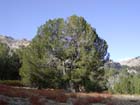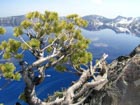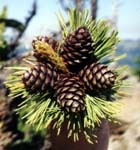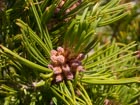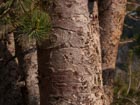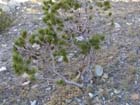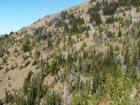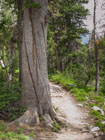Pinus albicaulis (whitebark pine) description (original) (raw)
Illustration of tree, cones, seeds, foliage, and Clark's nutcracker [Matt Strieby, 2018].
Very large tree in Lamoille Canyon, Nevada [C.J. Earle, 2001.09.24].
Small, gnarled, but mature tree at Crater Lake, Oregon [C.J. Earle, 2008.06.28].
Seed cones, Crystal Mountain, Washington [C.J. Earle, 1999.08].
Pollen cones and foliage, Wallowa Mountains, Oregon [C.J. Earle, 2008.07.19].
Bark of a tree 20 cm diameter at Sonora Pass, California [C.J. Earle, 2008.06.29].
Young trees about 50 cm tall. There are four stems growing from the same small patch of ground, evidence that all of these trees sprouted from a single nutcracker seed cache. Lamoille Canyon, Nevada [C.J. Earle, 2001.09.24].
Krummholz tree in the Wallowa Mountains, Oregon. The low "skirt" is protected from winter winds by a blanket of snow; dead orange foliage shows that the snow accumulation during the previous winter was less than usual, allowing death of these needles. Immediately above the "skirt" a bare trunk is exposed; at these heights, ice particles blown along the snow surface will abrade the cuticle from any exposed foliage, killing it. At greater heights above the snow surface this effect diminishes and foliage survival is possible [C.J. Earle, 2001.09.24].
A "ghost forest" in the Olympic Mountains of Washington. The white snags are trees killed by white pine blister rust when it first reached this site, decades earlier. The yellow-green trees are young P. albicaulis and P. contorta that have since regenerated. The dark green and blue-green trees are mostly Abies lasiocarpa and Tsuga mertensiana [C.J. Earle, 2009.09.22].
An extraordinarily large and old krummholz tree growing near the alpine timberline on a lava flow at Mount Adams, Washington [C.J. Earle, 2009.09.25].
A mature tree in Grand Teton National Park that has experienced multiple lightning strikes [C.J. Earle, 2013.07.24].
A very healthy, all-aged stand of trees in Paintbrush Canyon, Grand Teton National Park [C.J. Earle, 2013.07.24].
Pinus albicaulis
Common names
Whitebark pine, whitestem, alpine whitebark, pitch, scrub or creeping pine (Peattie 1950); white pine (Little 1980); pine à blanche écorce (Kral 1993).
Taxonomic notes
Syn: Apinus albicaulis (Engelmann) Rydberg. Belongs to subsection Cembra, the stone pines, so called for their large, wingless seeds.
The type specimen was collected at the “summits of Cascade Mountains" by John S. Newberry during his 1855 work on the Williamson Pacific Railroad Survey. Newberry described it as "Pinus cembroides" and it was recognized and described as a distinct species by Engelmann in 1863 (Newberry 1857, Engelmann 1863).
Description
Evergreen monoecious trees to 21 m tall and 150 cm DBH, usually single-trunked, initially with a conical crown, markedly rounded to irregular (the round crown, when present, distinguishes this species even at a considerable distance). Bark at first pale gray, with age darkening somewhat and forming thin plates. Branches spreading to ascending, often persistent to trunk base; twigs stout, pale red-brown, with a light brown, often glandular pubescence, somewhat roughened by elevated scars, aging gray to pale gray-brown. Buds ovoid, light red-brown, 0.8-1 cm; scale margins entire. Leaves 5 per fascicle, mostly curved, persisting 5-8 years, 3-7 cm x 1-1.5(-2) mm, deep yellow-green, abaxial surface less so, adaxial surface conspicuously whitened by stomata, margins rounded, minutely serrulate distally, apex conic-acute; sheath 0.8-1.2 cm, shed early. Pollen cones cylindro-ovoid, ca. 10-15 mm long, scarlet. Seed cones borne in upper crown, remaining on tree (unless dislodged by animals), not opening naturally but through animal agency, spreading, symmetric, broadly ovoid to depressed-ovoid or nearly globose, 4-8 cm, dull gray- to black-purple, sessile to short-stalked; scales thin-based and easily broken off; apophyses much thickened, strongly cross-keeled, tip upcurved, brown; umbo terminal, short, incurved, broadly triangular, tip acute. Seeds obovoid, 7-11 mm long, brown, wingless, edible. 2_n_=24 (Kral 1993 and pers. obs.). See García Esteban et al. (2004) for a detailed characterization of the wood anatomy.
In the absence of cones, whitebark pine strongly resembles P. flexilis, and may also be confused with P. monticola. The following points may be helpful in distinguishing the three species.
- The cones of the three species are very distinct. P. albicaulis cones are rarely seen, since they are targeted by corvids and rodents while still ripening; however, the scales and axils of the disarticulated cones can often be found on the ground beneath the tree. Unfortunately, none of the three species typically bear cones in the first few decades of their growth.
- P. flexilis twigs become roughened at a smaller size (usually <10 cm diameter, vs. > 10 cm diameter in P. albicaulis).
- On larger trees (>30 cm dbh), P. flexilis bark is usually composed of longitudinal reddish-brown plates with intervening fissures, and P. monticola bark develops roughly hexagonal plates, while P. albicaulis bark becomes light brown and platy without conspicuous fissures.
- When in flower, P. albicaulis pollen cones are a striking red color; P. flexilis cones can be bright red but often are a paler red or yellow, and P. monticola cones are yellow.
- The foliar units differ in texture; in P. monticola the fascicles are loosely bunched so that it's difficult to distinguish individual fascicles except with close inspection, and the needles quite flexible; while on P. albicaulis the fascicles are clearly distinct at a distance and the needles slightly stiffer. P. flexilis needles are nearly the same, but even a bit stiffer.
- Because P. albicaulis typically sprouts from seed caches, the young trees commonly have multiple stems of genetically distinct individuals. Due to their genetic differences, the saplings commonly show different growth habits and rates, and typically only one survives to maturity, the others dying due to competition and other stresses. Conversely, multiple-stem individuals are quite rare in P. flexilis or P. monticola.
- The foliage of P. albicaulis is said to have a sweetish taste and odor when crushed (Little 1980), but I have not found this to be a reliable or consistent character.
- Kral (1993) contends that bud scale margins are entire in whitebark pine, whereas lower bud scales have ciliolate margins in limber pine; I have not tested this assertion in the field.
These differences can be seen without a trip to the field, if you study lots of photos at the iNaturalist pages for these three species.
Distribution and Ecology
US and Canada: At montane to timberline elevations in the Rocky Mountains of Alberta, British Columbia, Montana, Idaho and Wyoming; in the Coast Mountains of British Columbia; in the Cascade Mountains of Washington and Oregon; and in certain isolated intermountain ranges of eastern California and Nevada (Little 1980, Kral 1993). A 2019 assessment of all geolocated specimens shown in the range map found elevation ranging from 1159 to 3700 m, with maximum elevations roughly declining with latitude; there is also a maritime effect, with lower elevations in those parts of Washington and British Columbia where very high winter snowfall results in a relatively short growing season. Also see Thompson et al. (1999). Hardy to Zone 2 (cold hardiness limit between -45.6°C and -40.0°C) (Bannister and Neuner 2001). Curiously, this species has been falsely described from Saskatchewan, Colorado, and Utah by various reputable authorities; perhaps this attests to the challenge of distinguishing it from other high-elevation 5-needle pines, especially P. flexilis.
Species distribution. Data sources include (1) polygons generated by USGS (1999), (2) point data (n=343) sourced from GBIF (2019), (3) point data from Conifers of the World (n=122, accessed 2019.07.15), and (4) point data representing my observations of the species in habitat (n=96). GBIF points are identified by their GBIF catalog number. GBIF data have been limited to georeferenced occurrences with coordinate uncertainty less than 5,000 m, with deletion of some suspect occurrences. Point data colors denote elevation (see pull-out menu for values).
Warwell and Shaw (2017) present results of a common-garden experiment documenting climate-related genetic variation in P. albicaulis. This sort of information is potentially useful in studies of how this species will respond to stresses, such as intensified drought, that may result from climate change.
White pine blister rust (Cronartium ribicola), an introduced fungal disease, has decimated formerly extensive stands of this and certain other white pines. Mortality has been especially severe in portions of the range north of 45° latitude or west of 120° longitude (Hoff et al. 1994). At this time, most areas that have been hit by this infestation are still characterized by "ghost forests" consisting of the whitened snags of trees killed by the blister rust; these ghost forests are the rule rather than the exception within the range of the species. However, the species has not been extirpated from these areas; currently the trees commonly show some level of attack by the fungus, but nonetheless achieve ages that allow them to bear cones and perpetuate the species, while still succumbing before they reach large size. Absent the effects of climate change, it would be reasonable to suppose that P. albicaulis would gradually develop a tolerance for the blister rust, as is seen in white pines of the Old World, most of which show some susceptibility to the disease but are not severely affected by it.
Climate change, however, is a substantial threat to the species. Keane et al. (2017) note that recent severe decline of whitebark pine forests has happened in response to the combined effects of mountain pine beetle (Dendroctonus ponderosae) outbreaks, fire exclusion policies, and white pine blister rust. Buotte et al. (2017) state that "recent mountain pine beetle outbreaks in whitebark pine forests have been extensive and severe" and that further outbreaks are likely as winter minimum temperatures become warmer, allowing the pine beetle to invade areas where it was formerly excluded by severe winter cold. Modeling of future conditions under alternative restoration, fire management, and climate change scenarios shows that whitebark pine's continued survival is possible, but requires active restoration efforts, and that the species will at best experience extirpation through about 50% of its historic range. In the absence of restoration efforts, outcomes are much worse (Keane et al. 2017). The potential for severe and rapid decline is the primary reason the IUCN lists the species as "endangered" despite its very large range and area of occupancy (Mahalovich and Stritch 2013).
Remarkable Specimens
The largest tree has diameter 268 cm, height 21.0 m, and crown spread 14 m; it grows in Sawtooth National Recreation Area, Idaho (American Forests 1996). Another has height 27.4 m, dbh 119 cm, and grows in the Alpine Lakes Wilderness of Washington (Van Pelt 1998).
The tallest specimen ever measured was found along the Cliff Creek trail in Eagle Cap Wilderness, Oregon, on 2008.07.22 by Keala Hagmann. We were backpacking and Keala said "is this a whitebark pine" and I naturally responded "No, whitebarks don't grow this low and that tree is way too tall for a whitebark." It turned out to be growing in the perfect location for a height record tree: near its lower elevation limits (2113 meters, low for this area), on deep loamy soils near a perennial water source, surrounded by even taller trees of other species (mostly Abies lasiocarpa and Picea engelmannii). We had a laser along and were able to confirm its height at 27.52 meters with a 104.4 cm DBH.
The oldest on record is Tree RRR15 collected in central Idaho, which had a crossdated age of 1267 years (Perkins and Swetnam 1996, cited by RMTRR 2006). Brian Luckman has a crossdated age of 882 years for a tree in the Rockies of Alberta (Luckman 2006). I sampled a stand in the Independence Mountains of Nevada that probably contained comparably-aged trees, and I suspect that other arid mountain ranges of the Great Basin also contain trees exceeding 1000 years.
Ethnobotany
Interior Salish peoples harvested the seeds by removing the cones and roasting them overnight. The seeds were crushed to make a flour. The fibrous roots were used to sew bark together and to weave watertight containers. The western world values whitebark pine for its aesthetic qualities and for its value as wildlife habitat (Parish et al. 1996).
The species has been used for dendrochronology, but has not proven particularly useful because of poor latewood definition and low interannual ringwidth variation. Most uses have been for ecological research.
Observations
I have found particularly fine stands in these spots:
- Atop the Little Belt Mountains of Montana (46.8°N, 110.7°W). This is a fine place to observe the successional relationships between P. albicaulis, Abies lasiocarpa, and Picea engelmannii.
- In the western Wind River mountains of Wyoming (43.0°N, 109.7°W), where successional relations are also apparent, in this case with Pinus contorta added to the mix.
- Near timberline in the Independence Mountains of Nevada (41.53°N, 115.97°W), where the trees attain great age (over 1,000 years) and are extremely picturesque.
- In the Lamoille and Thomas Canyons in the Ruby Mountains of Nevada (40.6°N, 115.4°W), both easily accessible by popular hiking trails, where P. albicaulis grows with P. flexilis, affording a fine opportunity to observe how these similar white pines compete to achieve stand dominance on different slopes and substrates, and at slightly different elevations. Thomas Canyon is also the only place in the world where these two species grow with bristlecone pine, P. longaeva, and is worth a trip just for that sight.
- Along the Summit Point trail in the Wallowa Mountains of Oregon (45.01°N, 117.25°W). The area has exceptionally large and old trees and is near the location of the tallest recorded tree, described above.
- Paintbrush Canyon in Grand Teton National Park, where some stands show no evidence of blister rust and some very large trees grow.
- Locations in Yellowstone National Park, where, due to the extensive fires of 1988, the species occurs as an early seral component of mixed Pinus contorta stands, occurring with P. flexilis and other conifers. Corvids planted seed caches widely in the aftermath of the fires, and many of these caches that sprouted P. albicaulis seedlings have subsequently found themselves being overtopped by young P. contorta forest. It seems reasonable to expect that these trees will eventually die either from shade or from the inevitable future fire, but at 30 years post-fire, they are still doing fairly well. It's a good place to practice your skills at distinguishing young trees of P. albicaulis from P. flexilis, because they commonly share this habitat.
- Additional locations described by Arno and Hammerly (1984).
Remarks
Whitebark pine, like other stone pines, has coevolved with nutcrackers (in this case, Clark's nutcracker, Nucifraga columbiana). The nutcrackers rely on stone pine seeds as their principal food source "for at least 9 months of the year and for raising the young. In addition to special adaptations on gathering, transporting, caching, and finding again the hoarded seeds, the whole annual cycle of the nutcracker's life (time of breeding and moulting), its mating system, and its habitat use are adjusted to the use of pine seeds" (Tomback et al. 1990). Moreover, since the whitebark pine's cones do not open, seed hoarding and caching by the nutcracker and related corvids (e.g., jays) constitute the only reproductive mechanism available to this pine (Tomback et al. 1990). The natural history of the stone pine/corvid mutualism is explored at length by Ron Lanner in his very engaging book Made for Each Other: A Symbiosis of Birds and Pines (1996).
The seeds are also an important food source for certain mammals: "Whitebark pine seeds are an important high-quality food for bear populations that occupy ecosystems with continental climates south of the United States - Canada border. Availability of pine seeds affects human-bear conflict and bear mortality. In most areas bears acquire whitebark pine seeds by excavating red squirrel (Tamasciurus hudsonicus) food caches... Bear use of pine seeds is restricted to stands >100 years old, and can persist for an additional 200 to 300 years" (Mattson and Reinhart 1994).
This species is one of the primary hosts to the dwarf mistletoe Arceuthobium cyanocarpum (Hawksworth and Wiens 1996).
Hybrids with P. flexilis have been reported on the Rocky Mountain Front in Montana, but are rare and infertile (Ericson 1965).
Citations
American Forests 1996. The 1996-1997 National Register of Big Trees. Washington, DC: American Forests.
Arno, Stephen F. and Ramona Hammerly. 1984. Timberline: mountain and arctic forest frontiers. Seattle: The Mountaineers.
Buotte, P. C., J. A. Hicke, H. K. Preisler, J. T. Abatzoglou, K. F. Raffa, and J. A. Logan. 2017. Recent and future climate suitability for whitebark pine mortality from mountain pine beetles varies across the western US. Forest Ecology and Management 399:132-42.
Engelmann, G. 1863. On Pinus aristata, a new species of pine, discovered by Dr. C. C. Parry in the alpine regions of Colorado Territory, and on some other pines of the Rocky Mountains. Transactions of the Academy of Science of St. Louis 2:205-210. Available: https://biodiversitylibrary.org/page/5787958, accessed 2019.07.15.
Ericson, John E. 1965. A suspected hybrid between Pinus albicaulis Engelm. and Pinus flexilis James. Proceedings of the Montana Academy of Sciences 25:58-59.
GBIF [Global Biodiversity Information Facility]. 2019. GBIF occurrence download, all georeferenced records of Pinus albicaulis. Source: https://doi.org/10.15468/dl.egppa0, accessed 2019.07.14.
Keane, R. E., Holsinger, L. M., Mahalovich, M. F. and Tomback, D. F. 2017. Evaluating future success of whitebark pine ecosystem restoration under climate change using simulation modeling. Restoration Ecology 25(2):220-233.
Luckman, B. H. 2006. Current research. http://geography.uwo.ca/facilities/dendro/tree-ring-research.pdf, accessed 2007.10.22, now defunct.
Mahalovich, M. and L. Stritch. 2013. Pinus albicaulis. The IUCN Red List of Threatened Species 2013: e.T39049A2885918. http://dx.doi.org/10.2305/IUCN.UK.2013-1.RLTS.T39049A2885918.en, accessed 2019.07.14.
Newberry, John S. 1857. General Catalogue of the Plants Collected on the Expedition, p. 90. Available: https://biodiversitylibrary.org/page/40843803, accessed 2019.07.15.
Perkins, D., and T. W. Swetnam. 1996. A dendroecological assessment of whitebark pine (Pinus albicaulis) in the Sawtooth-Salmon River region of Idaho. Canadian Journal of Forest Research 26:2123-2133.
Warwell, M. V. and R. G. Shaw. 2017. Climate-related genetic variation in a threatened tree species, Pinus albicaulis. American Journal of Botany 104(8):1205-1218, doi: 10.3732/ajb.1700139.
See also
Elwes and Henry 1906-1913 at the Biodiversity Heritage Library. This series of volumes, privately printed, provides some of the most engaging descriptions of conifers ever published. Although they only treat species cultivated in the U.K. and Ireland, and the taxonomy is a bit dated, still these accounts are thorough, treating such topics as species description, range, varieties, exceptionally old or tall specimens, remarkable trees, and cultivation. Despite being over a century old, they are generally accurate, and are illustrated with some remarkable photographs and lithographs.
The species account at Threatened Conifers of the World.
The Whitebark Pine Ecosystem Foundation. Excellent resource for anyone interested in whitebark pine.
Goheen, E. M. and R. A. Sniezko. 2007. Whitebark Pine: A Pacific Coast Perspective. U.S. Forest Service Proceedings R6-NR-FHP-2007-01. Available: https://www.fs.usda.gov/Internet/FSE_DOCUMENTS/fsbdev2_026092.pdf, accessed 2019.07.15. Many articles on whitebark ecology, threats, and restoration prospects.
A segment of about 5 minutes during Part 3, "Autumn", of the 2009 BBC documentary "Yellowstone," provides excellent footage and accurate commentary concerning the ecological role of whitebark pine vis-a-vis nutcrackers, squirrels, and grizzly bears. Available in various places on the Web. The same episode also discusses the threat bark beetles pose to whitebark pine while not mentioning the serious threat of white pine blister rust.
Kendall, Katherine C. 1995. Whitebark pine. In Status and Trends of the Nation's Biological Resources. USGS electronic publication. http://biology.usgs.gov/s+t/SNT/noframe/wm147.htm, accessed 2002.09.03, now defunct.

